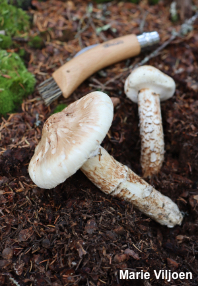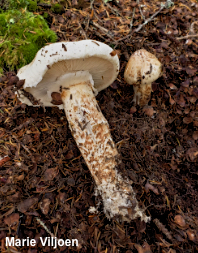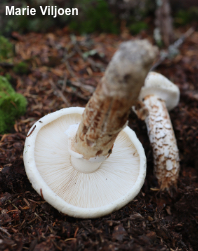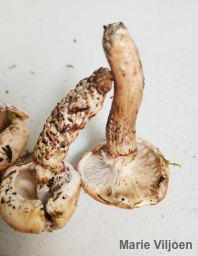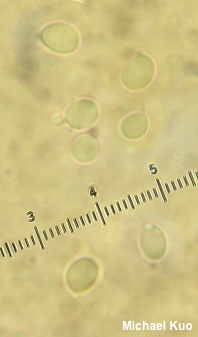| Major Groups > Gilled Mushrooms > Pale-Spored > Tricholoma > Tricholoma magnivelare |

|
[ Basidiomycota > Agaricales > Tricholomataceae > Tricholoma . . . ] Tricholoma magnivelare by Michael Kuo, 19 January 2023 Eastern North America's "matsutake," Tricholoma magnivelare, is a mycorrhizal associate with conifers, found in northern and montane (Appalachian) areas. It features a whitish to brownish cap with brown scales, and a brown-scaly stem that features a flaring ring. The gills and spore print are white. The mushroom's most distinctive feature, however, is its strong, spicy odor, reminiscent of cinnamon, mixed with something slightly funkier. The principal competitor for your identification attention is Tricholoma caligatum, which is probably a complex of several species in North America, all of which are associated with hardwoods and lack the matsutake odor (additionally they frequently have a strongly bitter taste). The name "Tricholoma magnivelare" was previously used for the western North American matsutake, as well, but recent research (Trudell et al. 2017) indicates that Tricholoma magnivelare is limited to eastern North America; the western North American version is a separate species, Tricholoma murillianum, while Tricholoma mesoamericanum is found in Mexico and Tricholoma matsutake is Eurasian. Thanks to Marie Viljoen for collecting, documenting, and preserving Tricholoma magnivelare for study; her collection is deposited in The Herbarium of Michael Kuo. Description: Ecology: Mycorrhizal with hard pines (those with needles in bundles of 2 or 3), including jack pine, red pine, and pitch pine—and with eastern hemlock; growing alone, scattered, or gregariously; originally described from New York (Peck 1873); distributed in the upper Midwest and northeastern North America, southward through the Appalachian Mountains; fall and early winter. The illustrated and described collection is from Maine. Cap: 4–9 cm; at first convex and brown, expanding to broadly convex and whitish or brownish with brown streaks and scales; dry or slightly sticky; the margin inrolled when young, and often hung with white partial veil remnants. Gills: Narrowly attached to the stem, sometimes by means of a notch; close; short-gills frequent; white; at first covered by a white partial veil. Stem: 4–10 cm long; 1–2 cm thick; more or less equal above a slightly tapered base; white above the ring, but with brown fibrils and scales, like the cap, below; partial veil white and thick, collapsing to form a flaring ring; basal mycelium white. Flesh: White; firm; not changing on exposure. Odor and Taste: Odor strong and spicy, somewhat reminiscent of cinnamon; taste similar. Microscopic Features: Spores 4–8 x 3.5–5 µm; broadly ellipsoid, with a small apiculus; smooth; hyaline in KOH, often with one large oil droplet; inamyloid. Basidia 28–35 x 4–6 µm; clavate; 4-sterigmate. Cystidia not found. Pileipellis a partially gelatinized cutis; elements 2.5–7.5 µm wide, smooth, hyaline to brown in KOH. Clamp connections not found. REFERENCES: (C. H. Peck, 1878) S. A. Redhead, 1984. (Smith, Smith & Weber, 1979; Ovrebo, 1980; Arora, 1986; Phillips, 1991/2005; Lincoff, 1992; Bergius & Danell, 2000; Chapela & Garbelotto, 2004; McNeil, 2006; Kuo, 2007; Bessette et al., 2013; Kuo & Methven, 2014; Trudell et al., 2017; Aoki et al., 2022; Bandala et al., 2022.) Herb. Kuo 10062201. This site contains no information about the edibility or toxicity of mushrooms. |
© MushroomExpert.Com |
|
Cite this page as: Kuo, M. (2023, January). Tricholoma magnivelare. Retrieved from the MushroomExpert.Com Web site: http://www.mushroomexpert.com/tricholoma_magnivelare.html |
